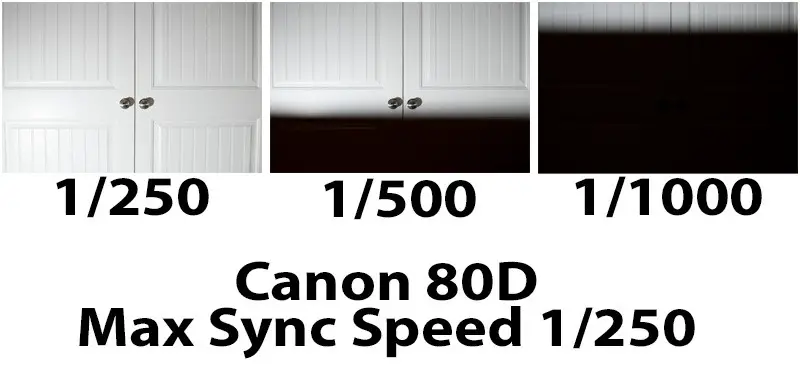You can end up with black bars across your photo if you are using flash and you have set your shutter speed faster than the “max sync speed” of your camera. Rarely can a camera have a shutter speed faster than 1/250 of a second but you have to check your manual for the specific “sync” setting for your camera.
Camera Curtains
Your camera shutter is made up of two curtains. When you press the shutter button the first (sometimes called front) curtain immediately opens as quickly as it can, trying to leave the sensor exposed to the light you are capturing in the photo. After the sensor has been open to receive light for the time of the shutter speed then the second curtain (sometimes called rear curtain) then closes back over the sensor.
During slow shutter speeds the movement of these two curtains looks very independent. The front (or first) curtain moves down exposing the sensor, time passes, and then the rear (or second) curtain goes down over the top of the sensor. However, your camera can only move those curtains so fast, and to get faster shutter speeds than the speed of those shutters we can begin moving that rear (or second) shutter down over the sensor very soon after the front (or first) curtain has started moving down to expose the sensor.
Max Sync Speed
The max sync speed of your camera is the fastest shutter speed you can set where the entire sensor is open to receive light at once. Meaning the first curtain has gone completely down to expose the sensor to the light and the second curtain hasn’t yet started to come down to block the sensor from getting anymore light.

When you use a flash to provide light to the photo this max sync speed becomes a significant factor. The light produced by the flash is going to illuminate the scene and hit your sensor for a much smaller amount of time than your shutter speed. Even if you set the shutter speed to 1/8000 the light from the flash is not there for that entire length of time. Only the portion of the sensor that is exposed when the flash pops will be hit with that light.
The image above provides a couple of examples. The max sync speed of the Canon 80D is 1/250. With the shutter set to that speed there is no curtain blocking the light from the pop of the flash from hitting the entire sensor. When the shutter is set to 1/500 the rear curtain has begun dropping over the sensor, blocking the light and making it look like there is a black bar across the photo. The problem gets worse as the shutter speed increases.
What is the Max Sync Speed For Your Camera?
This “sync” speed is different for every camera. It is not only specific to the brand of camera that you are using like Canon, Nikon, Fuji, Sony, Olympus, Panansoic, etc. It is also specific to the model of the camera. For example, not all Canon cameras have the same sync speed. This is a case where you need to consult your user manual and look for the word “sync” in there as they do not all call this important number the same thing.
You could also try google to see if the all-knowing search engine can find that for you. Try using a search of your camera make and model followed by “max sync speed”. If you are shooting a Nikon D7200 then you would search “nikon d7200 max sync speed” (which happens to be 1/250 just like the Canon 80D).
Is There a Way to Get Faster Shutter Speeds with Flash?
There is a feature with some flashes called “high speed sync” that can enable you to shoot at higher shutter speeds than this max sync speed. The flashes that support this feature are generally more expensive (though not always see Flash Kit Recommendations). The downside of high speed sync is a considerable loss in flash power and frequent use can lead to overheated (sometimes melted) flashes or flash modifiers.
However, the reality is that in most cases you don’t need to use a high shutter speed in order to freeze action. Unlike shooting in ambient light where high shutter speeds are a must, that flash pop happens so fast it will have the effect of freezing the motion of an action shot really well even if your shutter speed is 1/100. Don’t believe me, give it a try by taking a photo with a 3 second shutter speed that is lit by flash.
The only time high speed sync would be needed is shooting outdoors with a very bright sun and wanting to use a wide open aperture to blur the background. Shutter speed controls the amount of ambient light that will be picked up by the sensor (it doesn’t control how much light from the flash will get there) which is what you need in this scenario. A neutral density filter could also help you to accomplish this task.

Comments
Pingback: Six Creative Portrait Images With Connor Hibbs - Master Photography Podcast
Pingback: Getting Started With Team Sports Photography - Photo Taco Podcast
brilliant thank you so much